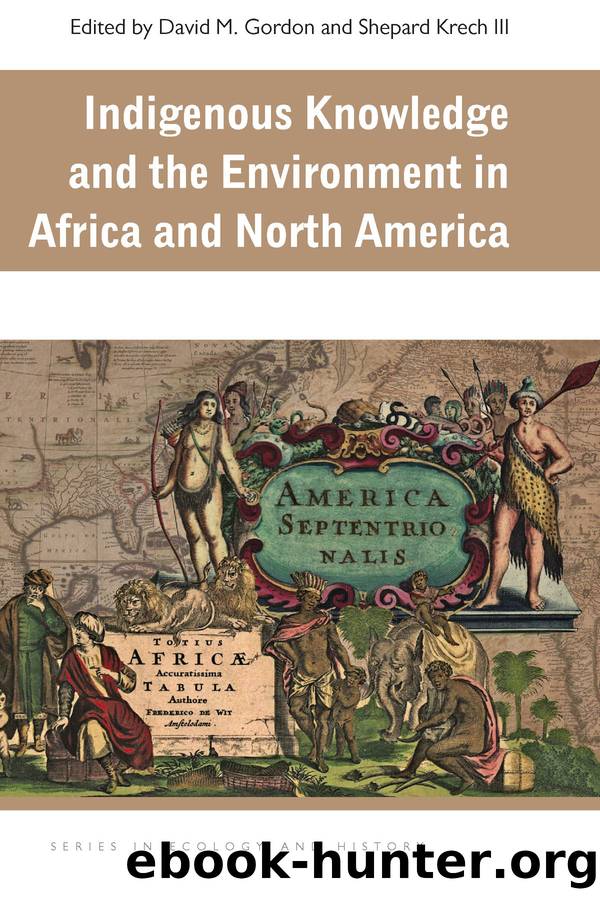Indigenous Knowledge and the Environment in Africa and North America by Gordon David M.;Krech III Shepard; & Shepard Krech III

Author:Gordon, David M.;Krech III, Shepard; & Shepard Krech III
Language: eng
Format: epub
Publisher: Ohio University Press
Published: 2012-08-15T00:00:00+00:00
Conclusions
The culture war over medicine continued after the 1824 epidemic. At times Christian evangelists even expressed dismay that they were losing to the âconjurors.â In 1827, the Reverend Isaac Proctor lamented that even those who had become church members still practiced native medicine. âTheir conjuring is as purely heathen as almost any thing to be met with on the River Ganges,â he informed his mission board. âWhen conjuring they pray to almost every creature such as white dogs, butterflies, turtles, etc. etc.â54 Daniel Butrick, though, did not let such backsliding pass. In 1828 the minister suspended two church members who had engaged in âconjuringâ and reported that âmy preaching respecting idleness, Sabbath breaking, but especially conjuring and my determined & public opposition to them has excited some feeling against me.â He admitted that church attendance dropped off but glossed over Cherokee opposition by claiming that âperfect order and regularityâ existed âin our meetings because none attend but such as wish to receive instruction.â55
Similarly, Charles Hicksâs converted brother, William, informed a Moravian âthat he had been endeavoring to relieve certain Heathen conjurors from their superstitious ways, but that as yet his exertions had been vain.â56 By the end of the 1820s, the Moravians and the ABCFM missionaries were joined by the Baptists and Methodists, but altogether they counted only 1,399 members among the nearly 15,000 Cherokees.57 Such diminutive numbers indicate that a large majority of Cherokees remained wedded to what the missionaries considered ancient beliefs and customs.
Scholars should not accept the missionariesâ claims of these medical beliefs and rituals as ancient. As the smallpox dance illustrates, the Cherokees adapted their indigenous knowledge to deal with the threats that colonialism and its germs presented. In 1824 Cherokees had further opportunity for creativity in the way they dealt with smallpox. Vaccine was available to them, and it was not out of the realm of possibility that offered to them under different circumstances, they would have accepted it. Because of the cultural war that the missionaries provoked, no middle ground existed in which natives could incorporate Euro-American medicine into their medicine. Indigenous knowledge and practices about smallpox remained one tool in the arsenal of Cherokee religious leaders in their counterattack against the growing influence of Christianity.
Download
This site does not store any files on its server. We only index and link to content provided by other sites. Please contact the content providers to delete copyright contents if any and email us, we'll remove relevant links or contents immediately.
| Civilization & Culture | Expeditions & Discoveries |
| Jewish | Maritime History & Piracy |
| Religious | Slavery & Emancipation |
| Women in History |
Cecilia; Or, Memoirs of an Heiress — Volume 1 by Fanny Burney(32434)
Cecilia; Or, Memoirs of an Heiress — Volume 2 by Fanny Burney(31869)
Cecilia; Or, Memoirs of an Heiress — Volume 3 by Fanny Burney(31852)
The Secret History by Donna Tartt(18843)
Sapiens: A Brief History of Humankind by Yuval Noah Harari(14248)
Leonardo da Vinci by Walter Isaacson(13179)
The Radium Girls by Kate Moore(11921)
Sapiens by Yuval Noah Harari(5293)
How Democracies Die by Steven Levitsky & Daniel Ziblatt(5127)
The Wind in My Hair by Masih Alinejad(5033)
Homo Deus: A Brief History of Tomorrow by Yuval Noah Harari(4822)
Endurance: Shackleton's Incredible Voyage by Alfred Lansing(4676)
The Silk Roads by Peter Frankopan(4456)
Man's Search for Meaning by Viktor Frankl(4420)
Millionaire: The Philanderer, Gambler, and Duelist Who Invented Modern Finance by Janet Gleeson(4374)
The Rape of Nanking by Iris Chang(4136)
Joan of Arc by Mary Gordon(4013)
The Motorcycle Diaries by Ernesto Che Guevara(4009)
Hitler in Los Angeles by Steven J. Ross(3900)
